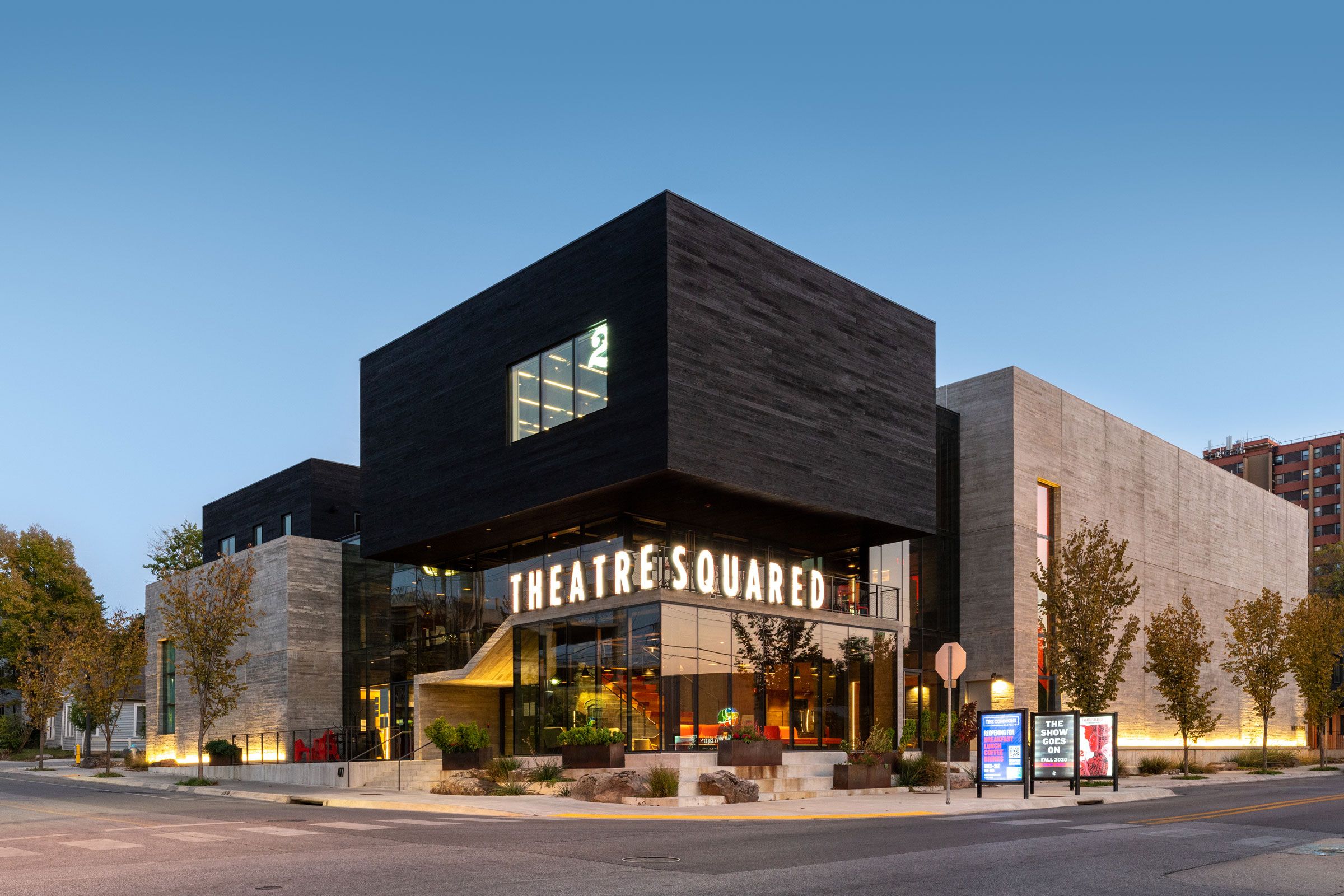Story at a glance:
- Shou sugi ban (traditionally known as yakisugi) is a Japanese wood preservation technique that utilizes charring and a natural oil sealant.
- Historically shou sugi ban has primarily been used for exterior cladding purposes, but recent years have seen it applied as an element of interior design.
- Aside from extending wood’s operation lifespan, shou sugi ban strengthens wood and makes it more resilient against weather, water, rot, and pests.
Yakisugi—or shou sugi ban as it’s known in the West—is a traditional Japanese wood preservation technique that utilizes controlled charring to strengthen timber.
Once an open flame has been applied to the wood, a wire brush is used lengthwise along the grain to remove any loose ash. Natural oil, such as linseed oil, is then brushed on to seal the wood.
Here we explore the history of shou sugi ban, its advantages and disadvantages, and potential applications, as well as take a look at a few examples from the field.
What is Shou Sugi Ban?

A polished concrete path leads to a triangular courtyard. The slatted roof aligns with slatted exterior walls to create long, vertical striations that begin at the roof ridge and cascade to the ground. Roof and exterior walls are constructed from charred, stained, and sealed Accoya rainscreen and Western Red Cedar rainscreen. Photo by Alan Tansey
Originally developed in 18th century Japan, yakisugi—which loosely translates to “to heat cedar with fire”—describes the process by which wood planks were charred as a way to make them stronger and more resilient.
Traditionally yakisugi planks were made from either cedar or cypress and were used to clad the exterior walls of homes, as they offered improved protection against the elements compared to virgin lumber.
Over time yakisugi became less and less popular as cheaper and less labor-intensive alternatives were made available. It would, however, see a resurgence in the late 1990s and early 2000s, at which point it was picked up by Westerners and marketed as shou sugi ban due to incorrect pronunciation.
Today shou sugi ban can be found in and on buildings all around the world and many companies have started experimenting with charred wood. Delta Millworks, for example, offers a wide selection of shou sugi ban products in a variety of colors, textures, and grain patterns.
What Makes Shou Sugi Ban Sustainable?
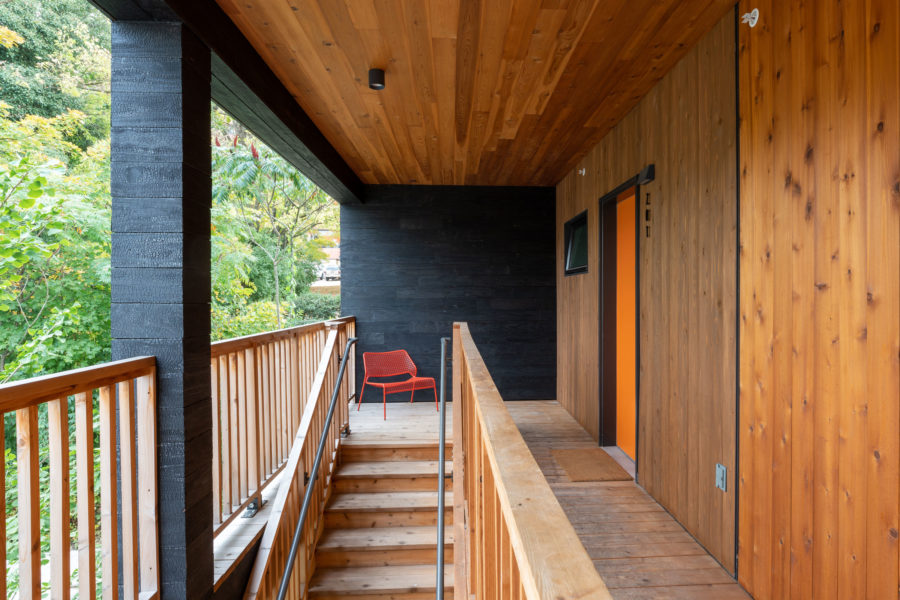
Arkansas pine board-formed concrete and Kebony Shou Sugi Ban modified wood, charred by Delta Millworks, make up the building’s facade. After the concrete was poured the pine was repurposed as interior finishes in the Spring theater and rehearsal room. Photo by Kristian Alveo
As long as the wood used in shou sugi ban was harvested ethically—as in it’s certified by the Forest Stewardship Council (FSC) or Sustainable Green Ecosystem Council—it is considered a sustainable product. Nakamoto Forestry and Delta Millworks are two companies that source their wood from sustainably-managed forests.
Wood is, after all, a renewable material, one that absorbs and sequesters carbon throughout its natural growth period. And while it’s true that the charring process produces a small amount of CO2 emissions, yakisugi does not require chemical preservatives or coatings that might release toxins over time.
Shou sugi ban can also be created using recycled lumber. This helps keep waste out of landfills and reduces the need for new resource extraction, which ultimately results in fewer emissions and a lower environmental impact.
Why is Shou Sugi Ban in Demand?
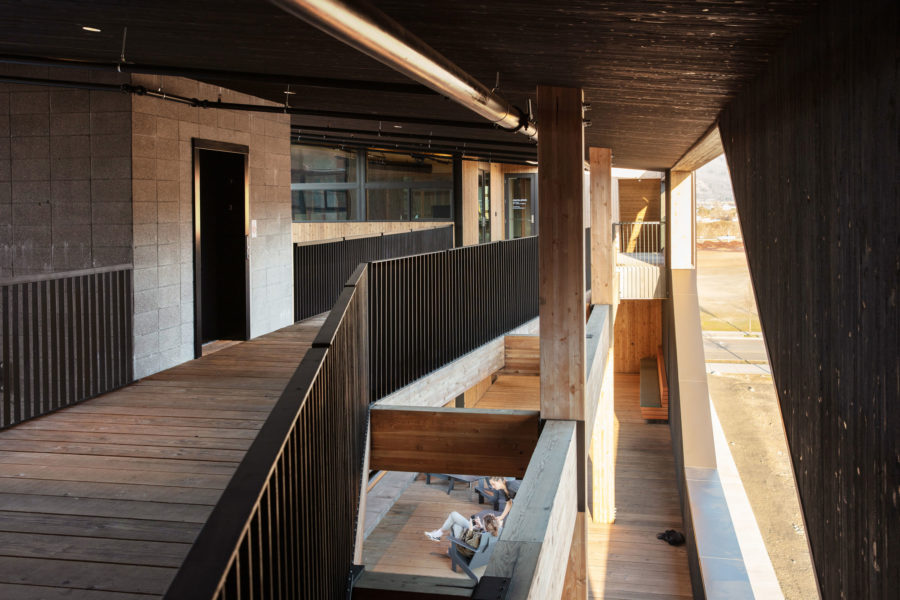
Skylab used finished cedar on the ground floor and charred cedar on upper levels for a sustainable and aesthetically pleasing choice at Outpost in Hood River, Oregon. Photo by Stephen Miller
Shou sugi ban has increased in popularity in large part thanks to its aesthetic qualities, as charred wood offers a unique appearance that simply can’t be replicated by staining. This has led to yakisugi being implemented indoors as well as outdoors.
“We are seeing a lot more people using heavily charred shou sugi ban for interiors, whereas in the past this was seen more as a wood for exterior cladding only,” Robbie Davis, owner and CEO of Delta Millworks, told gb&d in a previous article.
The fact that yakisugi is incredibly durable and greatly extends the lifespan of wood—without the use of chemical treatments—has also contributed to its renaissance. “That thick layer of char-induced carbon protects the wood from the elements and other things that might degrade it, so you can potentially avoid any sort of oil or other type of toxic coating,” Davis previously told gb&d.
Exterior Uses
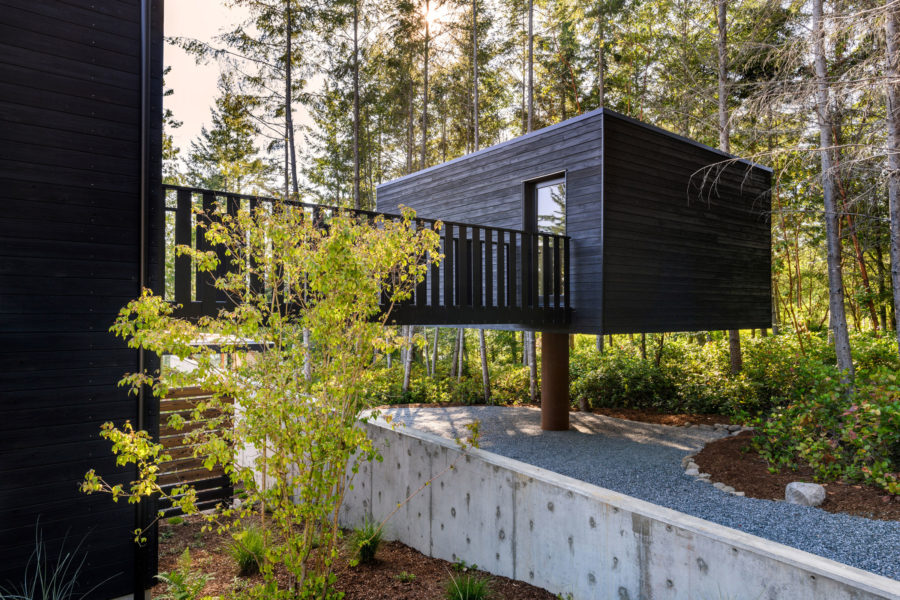
The Orcas House features Nakamoto Forestry’s Gendai and Pika-Pika shou sugi ban siding. Photo by Will Austin
Historically, shou sugi ban has almost exclusively been used as exterior wall cladding, though it has since found a plethora of additional outdoor uses in recent years, including:
- Decking
- Fencing
- Soffits
- Siding/cladding
Nakamoto Forestry is one of the world’s largest producers of shou sugi ban, supplying both Europe and North America with a range of authentically milled, heat treated yakisugi siding options. The Syndicate Smith-designed Orcas House, for example, is clad in two types of charred cypress planks from Nakamoto Forestry—the dark Gendai pre-finished in linseed black and lighter Pika-Pika, pre-finished in linseed natural.
Interior Uses
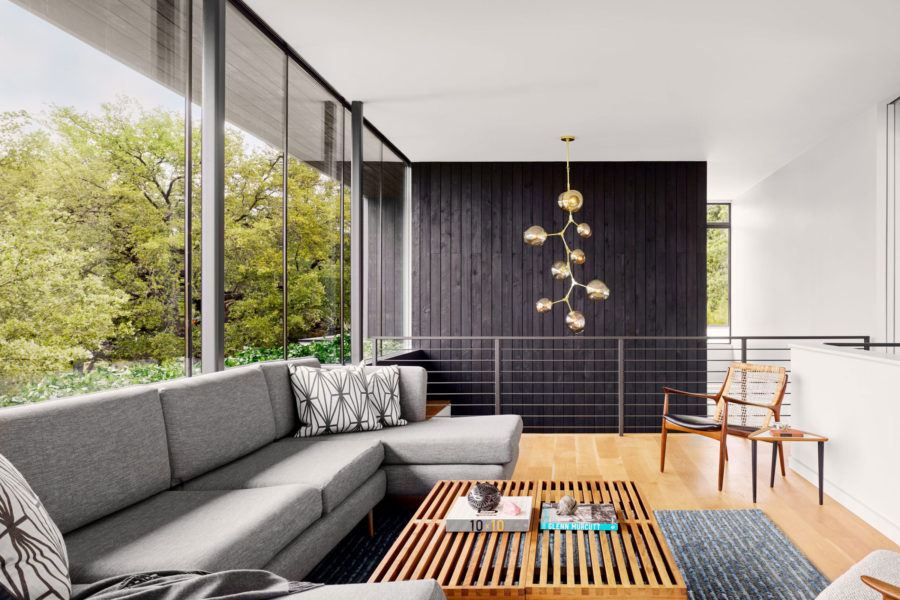
Charred Western Red Cedar is used as a design element that continues to the exterior at the Treetops Residence. Photo courtesy of Delta Millworks
While shou sugi ban was traditionally intended for exterior use, it has a variety of interior applications as well, including:
- Accent panels
- Flooring
- Ceilings
- Furniture
Charred western red cedar, for example, was used as interior paneling at the Treetops Residence in Austin, Texas. Designed by Specht Architects, the project uses Delta Millworks’ Western Red Cedar for both interior and exterior applications.
Benefits of Shou Sugi Ban
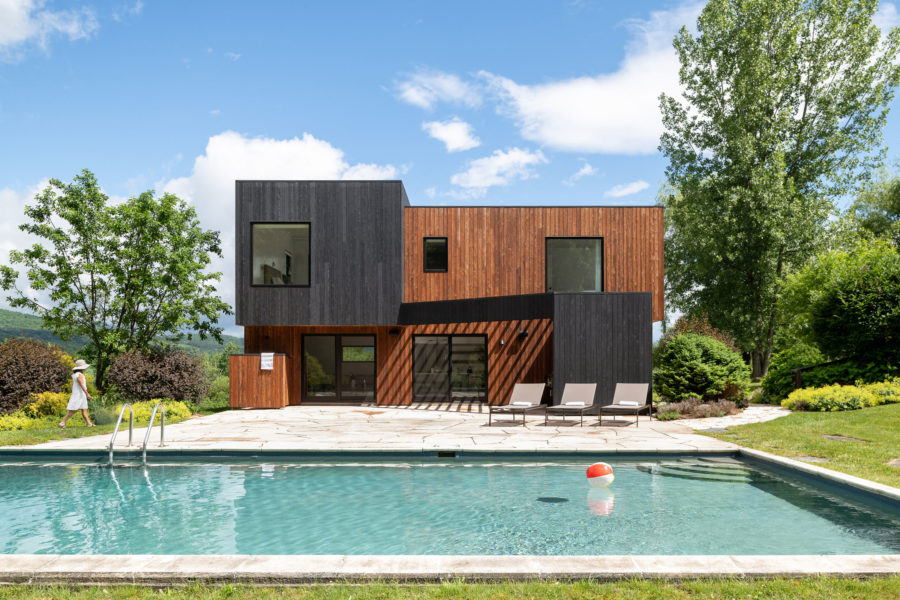
Designed by local architect Elizabeth Herrmann, the Mountain Pool House in Warren, VT makes use of Nakamoto Forestry’s Gendai and Pika-Pika shou sugi ban. Photo by Ryan Bent
Aside from being a sustainable material, shou sugi ban offers a host of other benefits, including:
Durable & Long-Lasting
Shou sugi ban is durable—which shouldn’t come as a surprise seeing as the technique was originally developed as a means of preservation. By lightly torching the wood, a layer of charcoal is formed across the surface, which helps harden and strengthen the timber.
Yakisugi also has a much longer lifespan than un-charred wood. As long as it’s properly maintained and cared for, shou sugi ban should last anywhere from 40 to 80 years.
Fire Retardant
Perhaps surprisingly, shou sugi ban is fire retardant—that is, it burns at a very slow rate. “They’ve done burn tests on wood timbers versus steel I-beams of the same size, and the I-beams ultimately fail first,” Davis previously told gb&d. “Once you burn that timber in one inch deep, the wood physically can’t burn any further on a big solid beam, even in a raging fire that’s engulfing the building.”
This is due to the fact that the wood’s most flammable component, cellulose, has already been burned away by the charring process, leaving only charcoal on the surface. Charcoal requires extreme heat to burn, which gives occupants more time to escape should the building catch fire.
Weather, Water, & Rot Resistance
Thanks to the carbonization that happens during the charring process (and partially due to the oil applied afterwards), yakisugi is made resistant to weather damage, moisture-induced rotting, and even wood-eating insects like termites and wood-boring beetles.
Uncharred lumber typically requires the addition of chemical treatments to achieve these qualities.
Aesthetically Pleasing
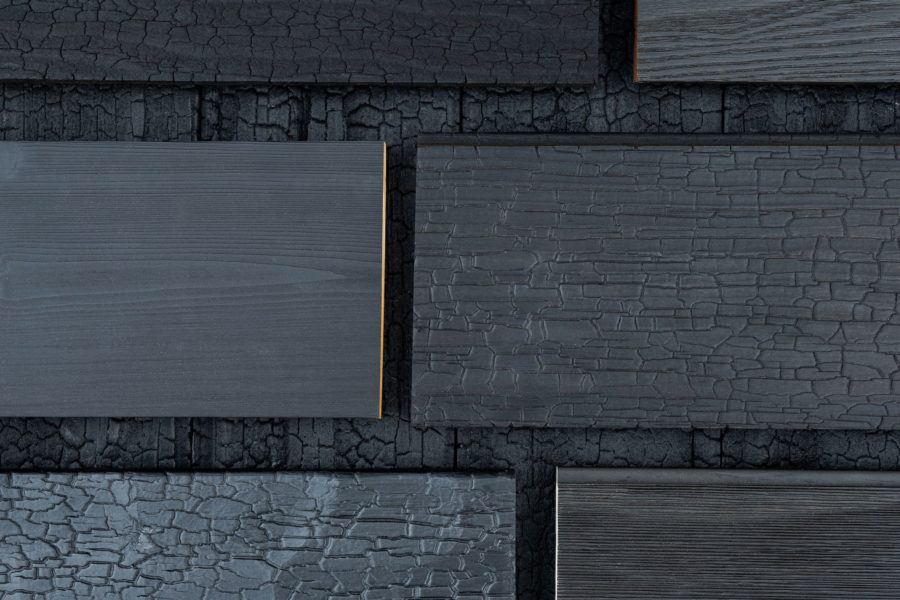
Delta’s custom finishes involve charring, brushing, and coating to achieve Gator, hand hewn, burned and brushed, and barnwood textures. Photo courtesy of Delta Millworks
One of the most striking aspects of shou sugi ban is its distinct appearance. Depending on the type of wood used, yakisugi can range in color from a very light gray to a deep black. What’s more, the charring process ensures that no two pieces look the same—a quality that adds character and lends a sense of artistry to any design that employs shou sugi ban.
Low Maintenance
Once installed shou sugi ban requires little to no maintenance whatsoever. When used outside, shou sugi ban only needs to be refinished with oil every 10 to 15 years, as is typical for most exterior wood products.
When installed indoors yakisugi only requires an occasional wipe-down to ensure it remains free of dust and dirt.
Disadvantages of Shou Sugi Ban
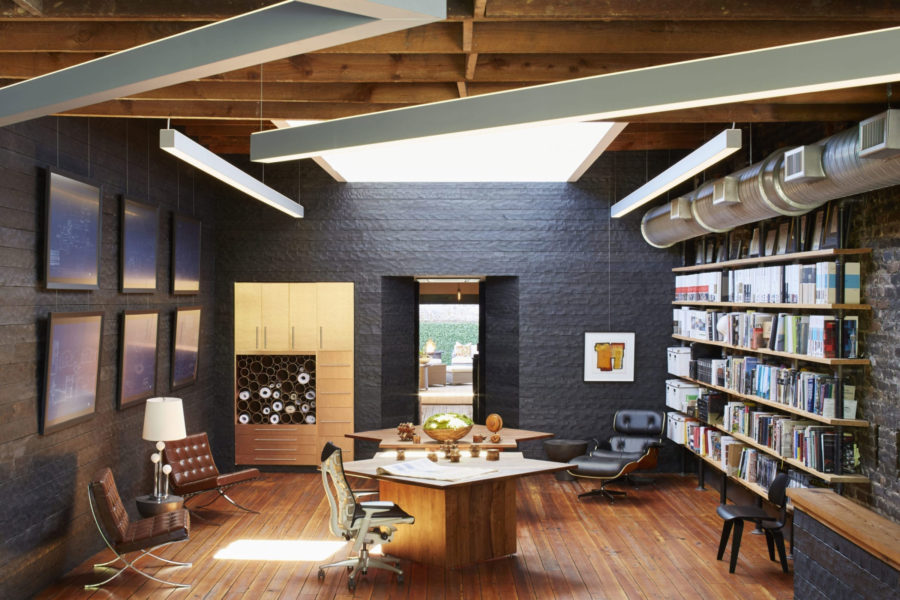
The Cevian Design Lab chose Accoya interior siding. Photo courtesy of Delta Millworks
There are, however, a few minor disadvantages to consider when it comes to shou sugi ban. Fortunately, they’re either worth it in the end or can be easily mitigated with the right know-how.
Expensive
Due to the extra labor involved in creating yakisugi, it typically costs more than traditional wood, leading to an overall increase in project expenses. The type of wood you use also influences the price—shou sugi ban is traditionally made from cedar, which costs more than pine or oak. That said, this added cost is generally justified due to the wood’s increased durability and longer lifespan.
Added Risk
As is the case for any product that includes the use of fire in its manufacturing process, yakisugi can pose a fire-hazard during its initial creation. This can, however, be easily mitigated by leaving the actual charring procedure to experienced professionals—which is typically the case anyhow.
5 Examples of Shou Sugi Ban
Now that we have familiarized ourselves with the basics of shou sugi ban, let’s take a look at a few real-world examples.
1. Sawyer Retreat, Sawyer, MI
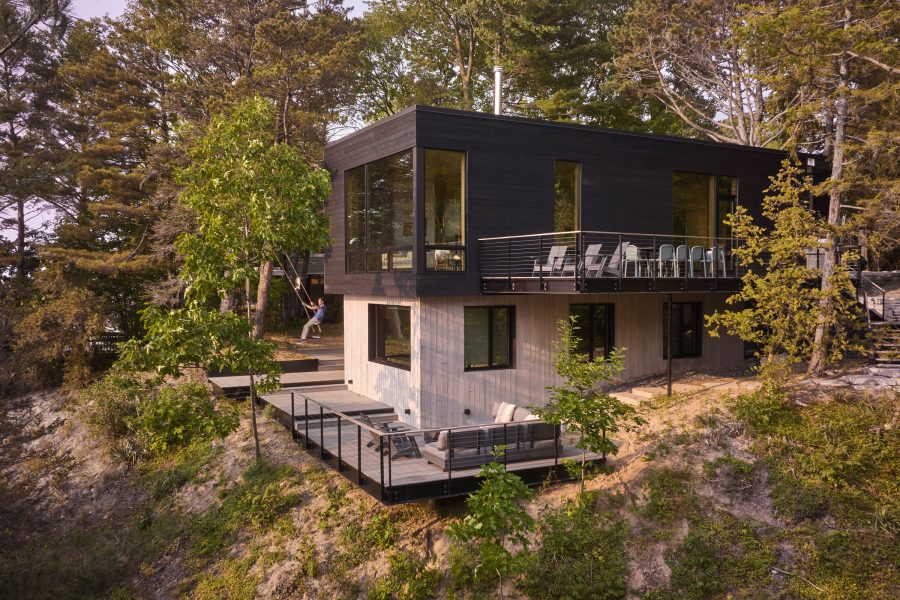
Designed by Wheeler Kearns Architects, the Sawyer Retreat is clad in dark Kebony yakisugi siding. Photo by Tom Harris
Just off the shores of Lake Michigan, the Sawyer Retreat was designed by Wheeler Kearns Architects as an extension of the surrounding landscape, conceptualized as a treehouse and appearing to almost float above the nearby dunes.
This illusion is achieved in part thanks to the project’s positioning on a steep lakeside bluff and the home’s separation into two rectangular masses stacked one on top of the other, with the second floor acting as the main entry point, connected via a thin wood-and-steel pedestrian bridge to the street. Dark Kebony shou sugi ban clads this top-most mass, making it appear as though the home is receding into the trees.
Like all of the home’s materials, the charred yakisugi siding was chosen due to its biophilic appeal, longevity, and low maintenance requirements. “All of the materials were geared around the idea that they are from nature, require minimal maintenance, and can stand the test of time. We’re hoping that this is a 100-years-plus home,” Michael Kendall, project architect at Wheeler Kearns Architects, previously told gb&d.
2. Meadows Haus, Park City, UT
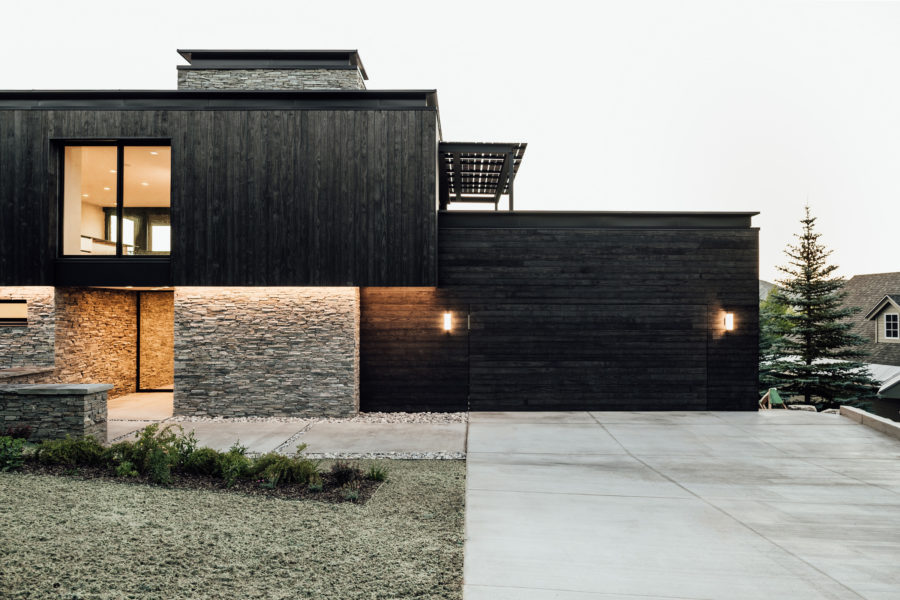
The Meadows Haus in Park City, Utah is clad in charred yakisugi siding from Delta Millworks. Photo courtesy of Delta Millworks
A collaboration between Klima Architecture and J Squared Interiors, the Meadows Haus was designed and built to Passive House standards in order to achieve maximum energy efficiency and ensure a minimal environmental impact.
All of the house’s shou sugi ban planks—including the accent paneling used indoors—were sourced from Delta Millworks and greatly influenced the project’s overall character while simultaneously contributing to its overall sustainability. Delta’s dark Accoya Gator siding sports a thick char and unique texturing while the company’s smooth Accoya | Barnwood 2.0 | Delta Black paneling imparts a sleek elegance throughout the home’s interior.
Because the wood has undergone an extensive charring process, it requires minimal maintenance and boasts an impressive longevity, all without necessitating the use of toxic sealants or stains.
3. South Haven Centre for Remembrance, Edmonton, Alberta
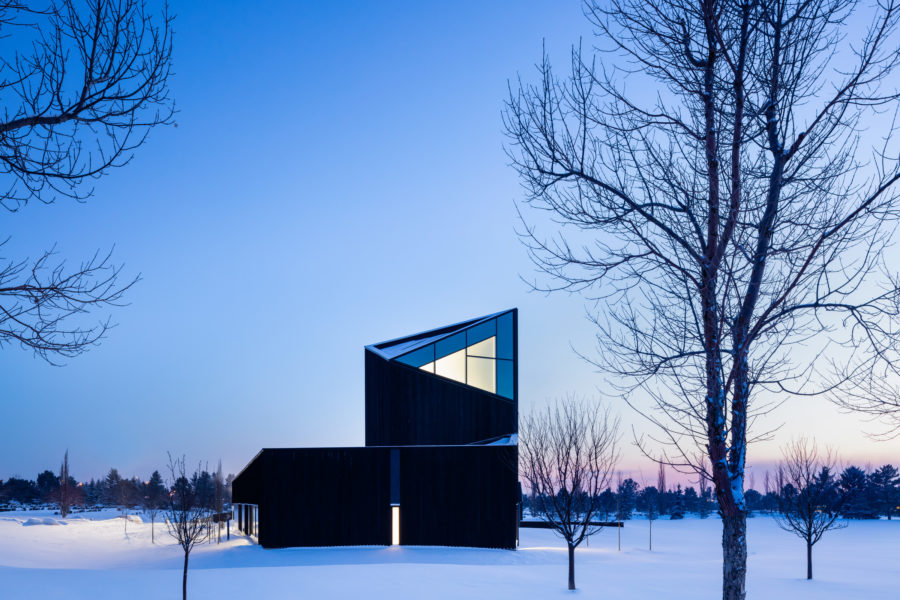
Delta Millwork’s Accoya wood was used for most of the siding on the South Haven Remembrance Center in Canada. Photo by Ema Peter Photography
Residing on a quiet plot of land in Alberta’s capital, the non-denominational South Haven Centre for Remembrance dutifully provides cemetery services for those who have passed on. Designed by Shape Architecture, the building is laid out in a wandering line, defined by its sharp angles and a lack of ornamentation.
A 43-foot-tall tower emerges from the center’s partially submerged form, symbolically mirroring the existing grave sites, monuments, and columbaria found throughout the sprawling prairie landscape. At the tower’s peak, a large triangular clerestory window—strategically positioned to admit light from the north—provides the meeting rooms below with diffuse natural light.
Like the Meadows Haus, the South Haven Centre for Remembrance employs Delta Millworks’ Accoya | Barnwood 2.0 | Delta Black yakisugi siding, the planks’ dark char helping to imbue the structure with somber reverence. This dark exterior, however, stands in sharp contrast to the center’s bright interior, its light-colored palette creating a warm, welcoming space conducive to reflection and moments of pause.
4. Silver Rock Living Building Home, Bainbridge Island, WA
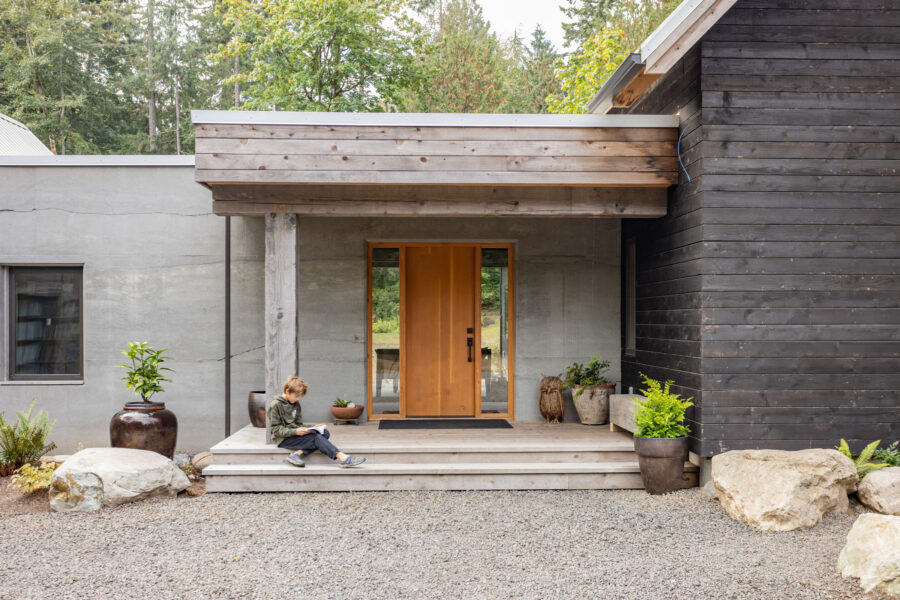
The Silver Rock residence on Bainbridge Island is a Living Building designed by McLennan Design that employs yakisugi as exterior siding. Photo by Emily Hagopian
Located on Bainbridge Island, Washington and designed by McLennan Design, the Silver Rock Living Building Home is an excellent example of how shou sugi ban can be implemented sustainably. All of the wood used for the exterior yakisugi siding was milled from second-growth cedar trees cut down on the project site, greatly reducing the amount of emissions produced by transportation.
“The outside of the home features charred shou sugi ban cedar siding to ensure longevity without the use of chemicals, paints, and stains,” Jason McLennan, principal at McLennan Design, previously wrote for gb&d. “The house feels natural and part of the landscape as a result of its materials and color palette.”
Other sustainable features of this green house include the use of passive solar design, rammed earth walls, FSC-certified timber, and solar panels.
5. TheatreSquared, Fayetteville, AK
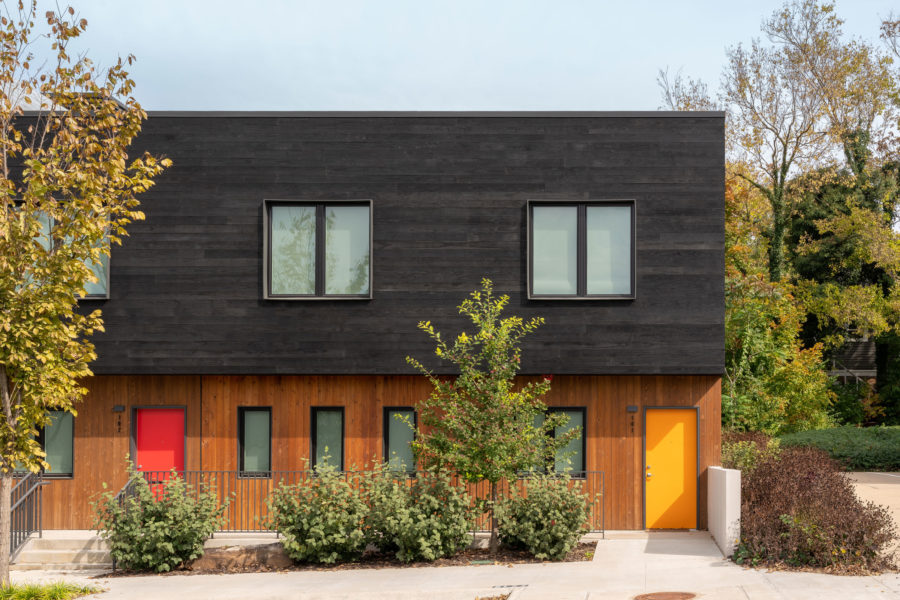
TheatreSquared features a striking Kebony Shou Sugi Ban and Arkansas pine facade. Photo by Kristian Alveo
Completed in 2020 and designed by Marvel Architects, TheatreSquared is an inspiring example of sustainable theater design in action—one that also employs charred yakisugi siding.
Located in Fayetteville, Arkansas, TheatreSquared makes use of Delta Millworks’ Kebony Shou Sugi Ban alongside Arkansas pine in its exterior cladding. The resulting effect is a beautiful contrast, with the dark, almost black shou sugi ban complimenting the warm browns of the Arkansas pine.
While already strengthened through the charring process, TheatreSquared’s shou sugi ban cladding is made even stronger by its use of Kebony wood, an environmentally-friendly engineered wood that has improved resiliency over normal hardwoods.

